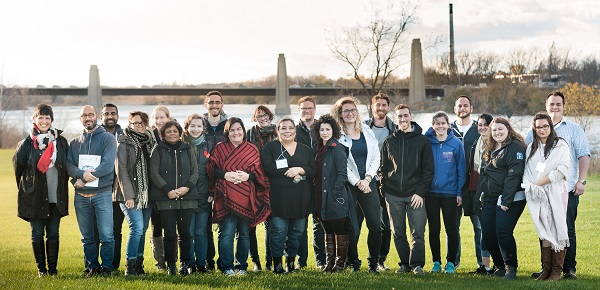Learning about Indigenous law
November 13, 2017
Share
Students, faculty, and staff in the Faculty of Law recently visited Akwesasne Mohawk Territory to learn more about the reserve’s unique court system and gain a broader perspective on how the law works in Indigenous communities.
“We wanted to ensure that the Queen’s community is fully engaged and, as responsible citizens, doing what we can to learn about both Indigenous law and culture,” says Heather Cole (Artsci’91, Law’96, MPA’00), event founder and Assistant Dean in the Faculty of Law. “I think everyone involved learned a great deal. We will continue to work with our Indigenous partners and hope to make this workshop an annual event.”
The day-long workshop began with an opening thanksgiving address, and an orientation to the community. Following the introduction, a number of speakers shone a light on how dispute resolution is handled in the territory, gave an overview of the history of the court, spoke about treaties and the drafting of laws, and took questions.
“Akwesasne is not representative of every First Nations community but, as students at law and as law educators, it is important for us all to understand that there are functioning legal systems in Canada outside of the mainstream Western paradigm,” says Kayla Stephenson (Law’18), another event organizer.

Akwesasne Mohawk Territory was selected as the location for this workshop for a few reasons. The community is in close proximity to Queen’s, and the region straddles modern-day New York, Ontario, and Québec which adds to its complexity as a legal jurisdiction. Among First Nations communities, Akwesasne also stands out, according to Ms. Stephenson, because of its “intricate and long-standing” legal system – a system she became familiar with both because of her personal interest, and because of her summer spent working in the community for the Ministry of the Attorney General.
Akwesasne is the first and only Indigenous community in Canada to have established a court “for Indigenous people and by Indigenous people.” The court enforces 32 civil laws, while criminal matters remain the jurisdiction of the province or the federal government.
The event wasn’t about teaching the group how to practise law in the Akwesasne reserve, but rather to educate them about Indigenous legal principles which are expected to become more important to Canada’s legal landscape in the future. “The participants were humbled to see how intricate the system is and how long the legal structure has been upheld. They were blown away at how it functions independent of any outside support,” says Ms. Stephenson.
The workshop is one of several steps the Faculty of Law is taking to incorporate Indigenous perspectives into their work, aligning with the recommendations of the Truth and Reconciliation Commission Task Force Final Report. The Faculty is also exploring different projects with other neighbouring Indigenous communities aimed at both fostering understanding and supporting the communities.
“Our law school is committed to creating an inclusive community that is supportive of all students, and Indigenous students are an integral part of our community,” says Ms. Cole.
To learn more about Indigenous initiatives within the Queen’s Faculty of Law, please visit the Faculty’s website.